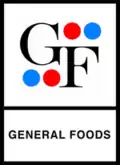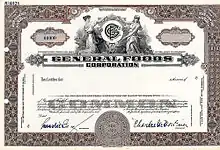General Foods
General Foods Corporation was a company whose direct predecessor was established in the United States by Charles William Post as the Postum Cereal Company in 1895. The name General Foods was adopted in 1929, after several corporate acquisitions, by Marjorie Post after she inherited the established cereal business from her father C.W. In November 1985, General Foods was acquired by Philip Morris Companies (now Altria Group, Inc.) for $5.6 billion, the largest non-oil acquisition to that time. In December 1988, Philip Morris acquired Kraft, Inc., and, in 1990, combined the two food companies as Kraft General Foods (KGF). "General Foods" was dropped from the corporate name in 1995; a line of caffeinated hot beverage mixes continued to carry the General Foods International name until 2010.
 General Foods' final logo, designed by Saul Bass, was used from 1985 until the merger with Kraft in 1990. | |
| Industry | Food |
|---|---|
| Fate | Acquired by Philip Morris and later merged with Kraft, Inc. |
| Successor | Kraft General Foods (now Kraft Heinz and Mondelēz International) |
| Founded | 1895 (as Postum Cereal company) 1929 (reincorporated as General Foods) |
| Defunct | 1990 |
| Headquarters | Tarrytown, New York, U.S. |
| Products | Post cereals, Maxwell House, Birds Eye, etc. |
| Parent | Philip Morris (1985–1990) |

History
C. W. Post established his company in Battle Creek, Michigan, having lived there since 1891, when he was a patient at a holistic sanitarium operated by Dr. John Harvey Kellogg.[1][2] Dr. Kellogg, with his brother W. K. Kellogg, had developed a dry corn flake cereal that was part of their patients’ diet. Post's first product, introduced in 1895, was not a cereal, however, but a roasted, cereal-based beverage, Postum. Having developed an aversion to coffee during his time in the sanitarium, Post positioned Postum as a healthy alternative. Its advertising slogan, which he coined himself, was, "There's a Reason." Postum's main ingredients were naturally caffeine-free wheat grain, bran, and molasses. Initially, Postum had to be brewed like coffee, but in 1911, Post introduced a powdered, instant formulation. This version of the product was manufactured in Battle Creek until it was discontinued in 2007. As of January 2013, Eliza's Quest Food had succeeded in returning Postum to many grocery stores across the United States and Canada.
In 1897, Post introduced his first dry cereal, a crunchy blend of wheat and barley, which he called Grape Nuts. His first corn-flake product was introduced as "Elijah's Manna" in 1904. Owing to consumer resistance to the (inaccurate) biblical reference[3] that was so great that even Great Britain flatly refused to register the name as a trademark, it was renamed Post Toasties in 1907.[4]
C. W. Post was an astute businessman who believed that advertising and aggressive marketing were the keys to a successful enterprise. Within 10 years of its incorporation, his Postum Cereal Company had more than $10 million in capital and was spending $400,000 a year on advertising, sums which were remarkable for the period.[5] Although he vigorously opposed labor unions, his employees were the highest-paid in his industry and working conditions at the Post factory were exemplary. He even developed a factory town in which he sold homes to his workers at favorable rates.
Postum Cereal Company lost its founder in 1914. C.W. Post underwent an apparently successful appendectomy at the Mayo Clinic, but shortly after returning home to recuperate, he died of a self-inflicted gunshot wound. Post had for years suffered from bouts of illness and depression. While his death was without warning, his company was not left rudderless. His daughter, Marjorie Merriweather Post, had been raised in the business and was familiar with virtually every aspect of its operations.[6] She assumed control of the now $20-million Postum Company and managed its affairs for the next eight years. While she did not oversee major product innovations, she did have a good feel for business and for promoting talented managers. In addition, her second marriage, in 1920, was to Edward F. Hutton, the founder of a brokerage firm on Wall Street.
Gross revenues in 1921 were $17.75 million.[7] In 1922, Hutton took the newly incorporated Postum Cereal Company public by issuing 200,000 common shares. The 1920s was a period in which common stock was still considered highly speculative, and consequently the newly issued shares carried a dividend at the rate of $5.00 per year.
Revenues in 1922 were essentially the same as in 1921, but in 1923, they were $22.25 million and a stock split, in the form of a 100% stock dividend, increased the authorized shares to 400,000. These shares also earned a $3.00 annual cash dividend, representing a 20% increase over the presplit rate. In 1925, with revenues now at $27.4 million, the stock was split once again and the dividend was increased to $4.00 per new share.
Major acquisitions
Starting in 1925, under the leadership of financier (and at one point, son in-law to the founder), E. F. Hutton as chairman and Colby M. Chester as president, Postum Cereal made the first of a series of corporate acquisitions which would within a few years transform it into the dominant U.S. packaged grocery products manufacturer.
It began late that year with the purchase of the Jell-O Company. Jell-O had been first produced in 1897 by Pearl B. Wait. His product was based on a patent that had been issued to Peter Cooper, the inventor and industrialist, in 1845, but which Cooper had never developed commercially. However, Wait was unsuccessful in marketing Jell-O, and in 1899, he sold the rights to it for $450 to a neighbor, Orator Francis Woodward, who had founded the Genesee Pure Food Company in 1897. Genesee became the Jell-O Company in 1923, the same year it began marketing D-Zerta, a sugar-free gelatin, and a powdered mixture for making ice cream in the kitchen.
In 1926, Postum Cereal acquired Igleheart Brothers, Inc (established in 1856), the makers of Swans Down cake flour, and followed this with the purchase of the Minute Tapioca Company. "Tapioca Superlative" had been invented in 1894 by a Boston woman, Susan Stavers, who made it from tapioca flakes that she ran through her coffee grinder. Later that year, she sold the rights to John Whitman, of Orange, Massachusetts, who changed its name to "Minute Tapioca". In 1908, he changed the name of his company to that of his product. The "Minute" brand would later become better known for a General Foods innovation introduced in 1949 known as Minute Rice, a brand of parboiled rice.
As a consequence of the Jell-O and Minute Tapioca acquisitions, Postum Cereal's revenues in 1926 jumped to $46.9 million. The number of shares stood at 1.375 million, including shares issued to acquire Jell-O and Minute Tapioca. The dividend was increased to $4.70 a year.
The acquisition spree continued in 1927 with the purchase of two similarly named confectionery companies, chocolate-maker Walter Baker (founded in 1765, making it the oldest component of the Postum constituent companies), and coconut-processor Franklin Baker, which had begun early in the 19th century as a flour broker, but whose confectionery products dated from 1895. This was followed by the purchase of Log Cabin Products, the maker of Log Cabin Syrup (first produced in 1887), and of Richard Hellmann, Inc (established in 1913), the producer of Blue Ribbon mayonnaise. And late in the year, Postum Cereal began selling its first coffee product, "Sanka", by obtaining US marketing rights from Dr Ludwig Roselius of Bremen, Germany. Roselius had developed the decaffeinated coffee in 1906 and began selling it in the US in 1923.[8]
Three more acquisitions followed in 1928. The most important was that of the Cheek-Neel Coffee Company. Its product, Maxwell House, dating from 1892, was a well-known brand in what was still a fragmented US coffee market. Within a few years, however, it was to become the number one brand in America and would retain that position well into the 1980s. Also acquired during 1928 was the La France Manufacturing Company, a maker of starch and other laundry products (this being Postum's first venture into nonedibles), and the Calumet Baking Powder Company, the leading maker of this kitchen essential.
Financially, the year culminated on October 1 with the inclusion of Postum, Inc in the newly reformulated Dow Jones Industrial Average of 30 common stocks.[9] By year-end, revenues stood at $101 million and the dividend on the five million authorized shares was $5.00 per year, a 25-fold increase since 1922.

Purchase of General Foods and renaming
By far the most important acquisition of 1929 was of the frozen-food company owned by Clarence Birdseye,[10] called General Foods Company. Birdseye (December 9, 1886 - October 7, 1956) was one of the most important entrepreneurs in the history of the food industry. Born in New York City, he became interested in the frozen preservation of food during the course of working as a fur trader in Labrador between 1912 and 1916. By 1923, he had developed a commercially viable process for quick-freezing foods using a belt mechanism, which he patented. In 1924, with backing from three investors, he formed the General Seafoods Company, in Gloucester, Massachusetts, to produce frozen haddock fillets packed in plain cardboard boxes.
The founder's daughter, Marjorie Merriweather Post, was first to become excited about the prospects for the frozen foods business. In 1926, she had put into port at Gloucester on her yacht, Sea Cloud, and was served a luncheon meal which, she learned to her amazement, had been frozen six months before. Despite her enthusiasm, it took Post three years to convince Postum's management to acquire the company. Postum paid $10.75 million for a 51% interest and its partner, Goldman Sachs, paid $12.5 million for the other 49%.[11] Following this acquisition, Postum, Inc changed its name to General Foods Corporation. Goldman sold its share back to General Foods in 1932, apparently at a slight loss.
Shortly after the acquisition, General Foods began test-marketing an expanded line of frozen foods, but the company quickly realized that a packaging process alone would not be sufficient to market frozen products in stores. To be sold, the packages had to be kept frozen while on display, so Birdseye engineers began development of a freezer cabinet designed specifically to hold frozen foods. The cabinet, which first appeared in 1934, required a great deal of space and electricity, which were not readily available in most grocery stores of the period. For those stores which could accommodate them, the payback was immediate. Housewives quickly realized that keeping packages of frozen food in the icebox could mean fresher meals and fewer trips to the market.[12]
The company published a cook book in 1932, the General Foods Cook Book, dedicated "To the American homemaker". Five editions were published between 1932 and 1937. The book includes photographs (among which is "General Foods offers over twenty famous products for your well-stocked pantry shelf") and a subject index.[13]
Timeline of selected later events
- 1953 - General Foods acquired Perkins Products Company, maker of Kool-Aid.
- 1957 - The company introduced Tang, which became available nationally two years later.
- 1959 - General Foods acquires Hostess Food Products.
- 1964 - General Foods introduced Maxim, the first American brand of freeze-dried coffee.
- 1968 - General Foods buys the Burger Chef fast-food chain.
- 1969 - General Foods buys Rax Restaurants.
- 1971 - General Foods acquired the maker of Gevalia.
- 1978 - General Foods sells Rax Restaurants to Rac.
- 1981 - General Foods acquires Oscar Mayer & Company.
- 1990 - General Foods merged into Kraft Foods.
- 2015 - Kraft Foods merges with Heinz.
See also
References
- The timeline and product history is adapted from "A Chronological History of Kraft General Foods, Inc.", prepared by the KGF Archives Department, Glenview, IL, c. 1994.
- Details of C. W. Post's career may be found in American National Biography, Vol. 7, pp. 725-7, published by Oxford University Press.
- In I Kings 17:6, Elijah was described as having ravens feed him "bread and meat," rather than manna, when in hiding from King Ahab. Exodus 16:31 describes manna as "white [and having a similar flavor to] wafers--made with honey," but the Israelites found it a poor daily substitute for the diet of meats, fishes, cucumbers, melons, leeks, onions, and garlic which they had enjoyed in Egypt.
- The Kellogg brothers had been selling their corn flakes and other cereal products since 1897, but with only limited success. Post, who took the cereal business seriously, was equipped to market and advertise his products nationwide; so successfully, in fact, that W.K. Kellogg broke away from his brother and in 1907 founded his own company, the Battle Creek Toasted Corn Flake Company (renamed the Kellogg Company in 1922). Kellogg's Corn Flakes eventually overtook Post Toasties in popularity and the latter brand is today only a minor player in the dry-cereal market.
- See International Directory of Company Histories, Volume 2, pp 530-32, published by St. James Press, 1990, for details relating to the company during this period.
- Biographical details of Post's life may be found in American National Biography, Volume 7, p. 732.
- Financial details for the company during this period may be found in the annual issues of ’’Moody’s Manual of Investments American and Foreign Industrial Securities’’, published by Moody’s Investor Services.
- "Sanka" is a contraction of the French words, sans caféine. Roselius for many years had had little success in finding a viable decaffeination process. Legend has it that when a shipment of green coffee sank in Bremen harbor, the beans came out caffeine free. Ultimately, Roselius settled on a washing process under more sanitary conditions. General Foods purchased Roselius's American company outright in 1932 and the original German company, Sanka HAG, AG, in 1979.
- djindexes.com
- Details of Birdseye's remarkable career may be found in American National Biography, Vol. 2, pp. 808-9.
- Following the sale, Birdseye remained in the frozen foods business. In 1932, he established Birds Eye Frozen Foods, which by later in the decade was selling almost 100 different frozen products. It is not immediately clear how General Foods came to acquire the product name, but Birds Eye frozen vegetables were a major component of its business until the division was sold to Dean Foods in 1993.
- The space and power requirements for the burgeoning frozen-food section was one factor which led to the rapid development of larger self-service supermarkets beginning in the late 1930s.
- General Foods Consumer Service Department General Foods Cook Book. New York: General Foods Corporation